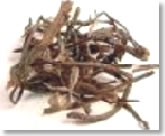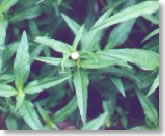BHRINGARAJA
Botanical Name: Eclipta alba ( COMPOSITAE)
English Name: False daisy
Hindi Name: Bhangra, bhringraj

Introduction:
Bhringaraja is known to therapeutics since very early times. Paraskara grihyasutra, Kesava paddhati, Sounakiya Atharva, Kousika sutra etc have mentioned about this plant. It is claimed to be useful in leucoderma (Svitra) and grey hair(Palita). It is famous for its Kesaranjana (artificial colouring effect) property. Charaka specially mentioned it in the treatment of Raktapitta ( bleeding disorders) while VAgbhata highlighted its Rasayana (anti-oxidant) property. In Rajanighantu (a Sanskrit lexicon on herbs) we come across another variant of Bhringaraja which is said to be blue in colour is also an eco-type of Bhringaraja. In Kerala, traditional vaids use another variety which is yellow in colour is botanically identified with Wedelia calendulacea. Vd. Bapalal described another variety which is red in colour and it is botanically identified as Flaviera rependa.
Distribution: A weed of moist places and up to 5000 ft in hills. Also found as a common weed of paddy fields and across water channels.
Chemical Constituents: Ecliptine, ecliptal, wedelolactone, des-methylwedelolactone etc.
Parts Used: Leaves and whole plant
Properties: Bitter & acrid, good for eyes j& teeth, tonic, hair growth promoting, hepatoprotective etc.
Indications: Jaundice (hepatitis), respiratory diseases, eye diseases, grey hair, head ache, inflammatory / non- inflammatory edema, anemia etc.
Dose: fresh juice 5-10 ml twice daily.
Therapeutic Uses:
- Hair tonic: Its juice along with S.nigrum fruit juice is applied externally.
- Night blindness: Fresh juice or paste of Bhringaraj is given with sugar orally.
Scientific Studies:
Anti-hepatitis B activity: E.alba is reported to be effective in converting the HbsAg positive patients to negative.
Hepatoprotective activity: Experimental studies prove that it protects the liver from the toxicity induced by alcohol, paracetamol & CCI4.
Anti-inflammatory activity: Significant anti- inflammatory activity reported ( Chandra et al., 1987).
Cultivation Technology: It prefers moist shady locations and grows commonly along water channels. The plant is easily propagated through its seeds or cuttings. The seeds are sown in the month of April-May and 5-20 cm long seedlings are transplanted to the main plots at the distance of 30x30 cm. Moist conditions should be provided for its better growth.
Harvesting: Mature plants are cut at the base with the help of sickle leaving 4-5 cm stumps for regeneration.








